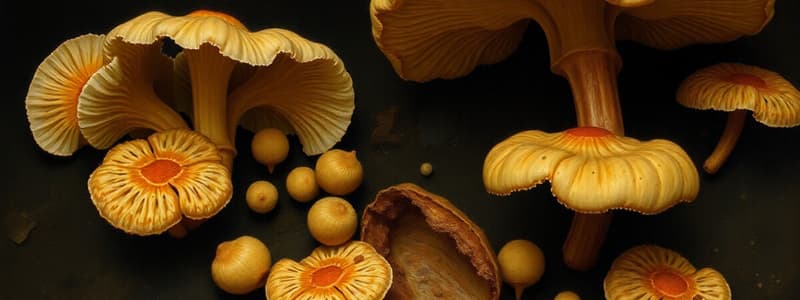Podcast
Questions and Answers
Arthrospores are spores contained within a sporangium.
Arthrospores are spores contained within a sporangium.
False (B)
Chlamydospores are characterized by their rectangular shape.
Chlamydospores are characterized by their rectangular shape.
False (B)
Blastospores are formed through the process of budding from a parent cell.
Blastospores are formed through the process of budding from a parent cell.
True (A)
Phialospores originate from pores on the surface of a fungal hypha.
Phialospores originate from pores on the surface of a fungal hypha.
Microconidia and macroconidia are produced by different species of fungi.
Microconidia and macroconidia are produced by different species of fungi.
Porospores develop by extending outward through small openings or pores.
Porospores develop by extending outward through small openings or pores.
Candida is the primary cause of dermatomycoses like tinea or ringworm.
Candida is the primary cause of dermatomycoses like tinea or ringworm.
Trichophyton species infect hair, skin, and nails, while Epidermophyton infects only skin.
Trichophyton species infect hair, skin, and nails, while Epidermophyton infects only skin.
Tinea cruris, commonly known as 'jock itch', affects the scalp.
Tinea cruris, commonly known as 'jock itch', affects the scalp.
Tinea pedis, also known as Athlete’s foot, is a fungal infection of the feet, whereas Tinea unguium is a fungal infection of the nails.
Tinea pedis, also known as Athlete’s foot, is a fungal infection of the feet, whereas Tinea unguium is a fungal infection of the nails.
Flashcards
Sporangiospores
Sporangiospores
Spores contained within a sporangium, a sac-like structure.
Conidia (Conidiospores)
Conidia (Conidiospores)
Spores that are not enclosed in a sac.
Arthrospore
Arthrospore
A rectangular spore formed by fragmentation of a fungal hyphae.
Chlamydospore
Chlamydospore
Signup and view all the flashcards
Blastospore
Blastospore
Signup and view all the flashcards
Phialospore
Phialospore
Signup and view all the flashcards
Superficial Mycoses
Superficial Mycoses
Signup and view all the flashcards
Dermatomycoses
Dermatomycoses
Signup and view all the flashcards
Tinea pedis
Tinea pedis
Signup and view all the flashcards
Tinea unguium
Tinea unguium
Signup and view all the flashcards
Study Notes
- Sporangiospores are spores contained within a sporangium.
- Conidia (condiospores) are spores not enclosed by a sac.
Types of Conidia
- Arthrospores are rectangular in shape.
- Chlamydospores are spherical.
- Blastospores bud from a parent cell.
- Phialospores bud from the mouth of a vase-shaped cell.
- Microconidia are one-celled spores.
- Macroconidia are spores with two or more cells.
- Microconidia and macroconidia are formed by the same fungus under different conditions.
- Porospores grow out through small pores.
Pathogenic Fungi: Superficial Mycoses (Cutaneous Mycoses)
- Dermatomycoses are also known as Tinea or ringworm.
Examples of Dermatomycoses
- Trichophyton affects hair, skin, and nails.
- Epidermophyton affects skin and nails.
- Microsporum affects hair and skin.
- Tinea capitis affects the scalp.
- Tinea corporis affects the body.
- Tinea cruris, also known as jock itch, affects the groin area.
- Tinea unguium affects the nails.
- Tinea pedis, also known as athlete's foot, affects the feet.
- Tinea versicolor causes discolored patches on the skin..
Studying That Suits You
Use AI to generate personalized quizzes and flashcards to suit your learning preferences.


